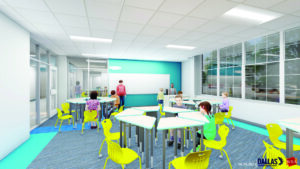By Judy Babb
As the COVID-19 pandemic progressed, school districts across Texas looked at virtual school options for students who wanted to stay virtual for 2021-22. The Texas Education Association was moving ahead with offering virtual school for students and parents who wanted it for their children.
All that planning came to screeching halt when the regular legislative session ended without passing House Bill 1468. Both Republican and Democratic lawmakers had supported the bill, which would have fully funded virtual education in Texas schools. But when Gov. Greg Abbott planned special sessions to pass the voting bill, Bill 1468 wasn’t included.Virtual school died on the vine.
Most districts closed down their online options for students. Frisco ISD, which had 5,000 students signed up for virtual learning, informed parents the option would not be available. Mesquite ISD folded its virtual program May 29, before the state failed to pass the bill June 5. Only 1 percent of Mesquite’s student population had indicated interest.

Dallas ISD is one of the few districts that still has a virtual component, and it’s not 100 percent virtual. The new middle school — Dallas Hybrid Preparatory at Stephen J Hay — will be remote three days a week and in person the other two. Students will attend Tuesdays and Thursdays. The school is located between Oak Lawn and the Dallas North Toll Road north of Wycliff Ave. It boasts small classrooms of approximately 12 students and extensive collaborative activities. It is open to both Dallas ISD students and to students from other nearby districts at no cost to them. The application form is on the Dallasisd.org web page.
Dallas ISD school board trustee Dan Micciche explained why they decided to offer the hybrid schools to students in the fourth through six grade level.
“We thought it was the right place to start,” Micciche said. “The kids are older and more adept at technology.”
The school’s principal, Dr. Olga Romero, speaks with enthusiasm about the new school. “It’s a small boutique-like school,” Romero said of the renovated building. “This year there will be only 75 students, but we know we will grow. Hay is in an historical building that has been redesigned to work best for this project-based school,” she said. Renderings of the building show it to be light filled and a cheerful atmosphere. On Tuesdays and Thursdays, students will be transported to and from Hay from their home school campuses. Those who don’t live in Dallas ISD will be able to go to a Dallas campus and get transportation.
The campus has been uniquely designed to provide the best learning. Rooms include a podcast room, a makerspace room and STEM classrooms where students build robots and prepare for careers in aerospace designing and environmental design, among others. The plan is to have students college ready and career ready.
Romero explained how the school will work. Four teachers will teach core subjects: reading, social studies, science and math. Two teachers will provide art, music and physical education.
“In addition, our ELA teacher will incorporate podcast production, and our math and science teachers will engage students in the Makerspace,” she said. “Students will also have enrichment every Wednesday with digital photography, African drumming and recyclable arts. On days at home, students will work in a flipped classroom.
According to the National Math and Science website, nms.org, a flipped classroom puts students in control of their class work.
“In a flipped classroom, students prepare to participate in class by watching video lessons, reading articles or doing other tasks that will take place during class time,” the website said. “This method allows students to spend more of their class time working on applications of what they learned in their homework, even if the class time is remote.”
The school is still taking applications from in-district students and those from other school districts. The plan is to add grades in future years.
While House Bill 1468 did not pass, schools that offered virtual classes before 2013 already have virtual schools. One of those is Grapevine-Colleyville ISD. It’s free to the student and is funded by the state. The website boasts that it is the highest performing virtual school in Texas. iUniversity Prep received the state’s accountability rating of “A” in addition to earning the English Language Arts/Reading, Science, Social Studies, Comparative Academic Growth and Postsecondary Readiness distinction designations.
Students in grades 5 to 12 can enroll in the iUniversity Prep program. A visit to iuniversityprep.org allows interested students and parents to learn about the school and even provides demo lessons. iUniversity Prep starts school on Aug. 16 and ends on June 3. But parents should look to see if online learning is best for their children. It’s not for everyone.
“We know many families have found the traditional learning environment is best for most kids,” Micciche said. “Some kids thrived in a hybrid setting.”
With that said, parents need to make a well-thought-out decision for their children. As school start dates are only days or weeks away, parents and their children still have a little time to make decisions. One thing for sure is that virtual school will be more rigorous this year. Expectations will be high. Parents should assess their children’s abilities to stay focused and their need for socialization.
